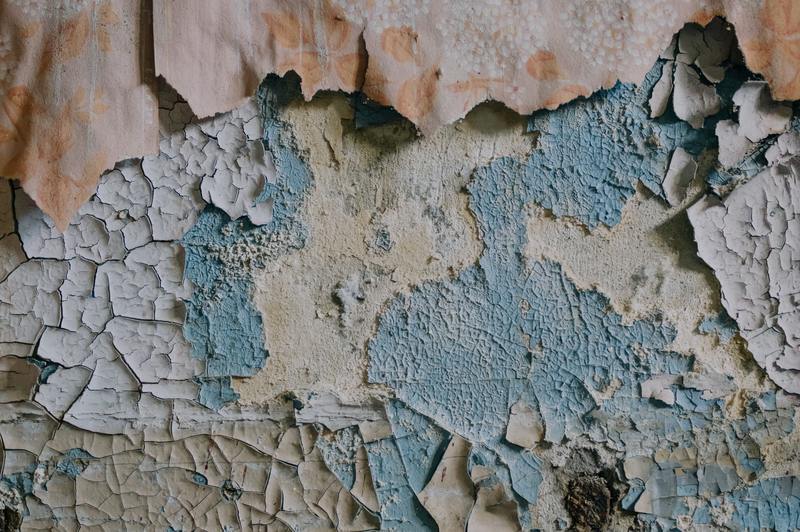The first process on what is required to repair water damaged paint is assessing the water damage. Assessment is used to gauge the effort and cost of your water damage reparations.
The details of what is done in the four processes are indicated below. We also included the materials you will need in the repainting process, so read this article until the end!

The Processes Of Painting Water Damaged Paint
There are four processes you need to do if you wish to fix your water-damaged paint. Moreover, within these processes that lead to repainting, there are multiple things you need to consider as well.
1. Assessment of damage
First, you have to assess the damage. Evaluating the damage comes in many forms.
You can inspect the roof of your house for missing shingles that may have led to roof and ceiling leaks. You can also have your plumbing system examined.
You can also opt to test the moisture level of your floors or walls. However, before doing those things, you may notice some changes in your home due to water damage.
Common among water-damaged paint is bubbling. Bubbling paint is due to loss of adhesion, and it is caused by moisture on the painted surface.
Apart from bubbling, cracking paint or peeling paint is also a common sign of water damage in your home. If your walls are light-colored, discoloration due to water stains (a sign of water damage) will be evident.
Part of assessing the damage is documenting it for your insurance claim. Take photos of structures that have been affected by water damage. Then, review your insurance coverage and policy with your lawyer.
2. Drying process
After assessing the damage of your water-damaged paint, proceed on drying the damaged structure. Drying is easy to do, but it takes a long time.
Damaged walls commonly take three to five days to dry. During this period, make sure to find the cause of the water damage and attend to it.
3. Restoration of furniture or structure
Before repainting the water-damaged paint, you have to fix the structure it’s adhered to first. To do this, remove the old bubbling or peeling paint.
There are numerous structures in your home that could acquire water damage. However, walls commonly sustain paint water damage the most, so we’ll use them as a general example.
A tip before removing your water-damaged drywall is to lay down pieces of cloth to catch the debris. Also, use protective gear like dust masks and safety goggles.
Use the hammer’s claw end to remove the affected area. If the damaged area is not significant, use a keyhole saw to cut the affected surface instead. Then, make appropriate repairs.
If you’re dealing with a small hole, use a joint compound layer and apply it around the hole. If the gap is significant, then use a replacement board and apply cement adhesive on the edges.
After repairing the gaps on your drywall, leave them to dry.
4. Repainting of water damage
After doing appropriate repairs on your drywall and letting them dry, sand them down. This is to even out the surface and to help the paint adhere to the drywall.
Apply a primer on the drywall, and allow it to dry. Finally, paint the restored area.
The Materials You Need
Under assessment
If you wish to test your walls or floors’ moisture level, then get a moisture meter. This will help you determine if there is moisture behind your walls or deep inside your floors.
Under drying process
To lessen the drying time of your drywall, use a dehumidifier or a fan. These two are the materials you need in the drying process of repairing water damaged paint. In line with this, make sure the room is well-ventilated.
Under restoration
Under the restoration process, you will need your dust mask and safety goggles to protect your eyes and mouth from the debris. You will need a putty knife to spread the joint compound and cement adhesives.
You will also need a utility knife for the replacement board. As for taking the affected drywall apart, you will need a hammer or a keyhole saw.
Under repainting
Lastly, under the repainting process, you will need sandpaper to smooth the surface. Another material you can’t leave out is the primer to ensure paint adhesion on the drywall.
Also, some primers have stain-blocking properties, which may resist water stains on your paint. For interior stains and odors, you can use either oil-based or water-based primers.
Although, water-based ones are easier to clean, and they are not odorous. If you ended up replacing your entire drywall, then we recommend using a drywall primer-sealer to keep a consistent sheen on your drywall.
Most importantly, you will need paint. Make sure the paint you buy matches your existing one.
Conclusion
Paint does not only beautify your walls, but it is also used to protect your surfaces from outside water damages. They also alert you of water damage that occurs behind your walls or your ceilings.
Hence, we wrote this article to inform you of what is required to repair water damaged paint. We hope this article about water damage repair was informational.
